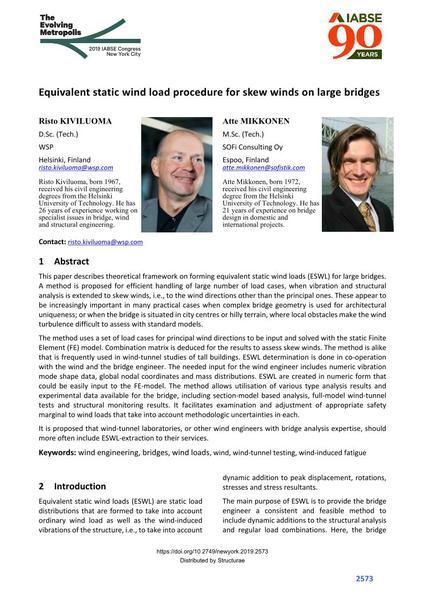Equivalent static wind load procedure for skew winds on large bridges

|
|
|||||||||||
Bibliografische Angaben
| Autor(en): |
Risto Kiviluoma
(WSP)
Atte Mikkonen (SOFi Consulting Oy ) |
||||
|---|---|---|---|---|---|
| Medium: | Tagungsbeitrag | ||||
| Sprache(n): | Englisch | ||||
| Tagung: | IABSE Congress: The Evolving Metropolis, New York, NY, USA, 4-6 September 2019 | ||||
| Veröffentlicht in: | The Evolving Metropolis | ||||
|
|||||
| Seite(n): | 2573-2579 | ||||
| Anzahl der Seiten (im PDF): | 7 | ||||
| DOI: | 10.2749/newyork.2019.2573 | ||||
| Abstrakt: |
This paper describes theoretical framework on forming equivalent static wind loads (ESWL) for large bridges. A method is proposed for efficient handling of large number of load cases, when vibration and structural analysis is extended to skew winds, i.e., to the wind directions other than the principal ones. These appear to be increasingly important in many practical cases when complex bridge geometry is used for architectural uniqueness; or when the bridge is situated in city centres or hilly terrain, where local obstacles make the wind turbulence difficult to assess with standard models. The method uses a set of load cases for principal wind directions to be input and solved with the static Finite Element (FE) model. Combination matrix is deduced for the results to assess skew winds. The method is alike that is frequently used in wind-tunnel studies of tall buildings. ESWL determination is done in co-operation with the wind and the bridge engineer. The needed input for the wind engineer includes numeric vibration mode shape data, global nodal coordinates and mass distributions. ESWL are created in numeric form that could be easily input to the FE-model. The method allows utilisation of various type analysis results and experimental data available for the bridge, including section-model based analysis, full-model wind-tunnel tests and structural monitoring results. It facilitates examination and adjustment of appropriate safety marginal to wind loads that take into account methodologic uncertainties in each. It is proposed that wind-tunnel laboratories, or other wind engineers with bridge analysis expertise, should more often include ESWL-extraction to their services. |
||||
| Stichwörter: |
Wind Brücken Windlasten
|
||||
